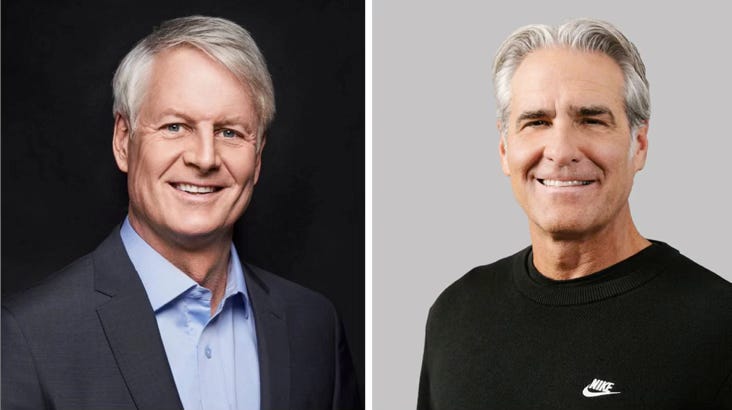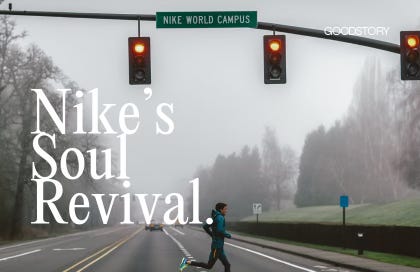Elliott Hill’s Return as Nike CEO: A New Era Begins
Much like Steve Jobs’ return to Apple, Elliott Hill’s comeback signals a pivotal moment for Nike to reconnect with its core values and innovation.
Hello Friends,
Last week's announcement of Elliott Hill's return as Nike's CEO sent a wave of excitement through the Nike alumni community. For many of us, his return feels less like a leadership change and more like a homecoming—a chance for Nike to reconnect with its core values and soul. It’s a return to what makes Nike, well, Nike.
You might wonder- why this matters to those who no longer work there? Simply put, Nike isn't just a job—it's a shared mission that stays with you long after you've left. We still say 'we' when talking about Nike because, as we learned, we always "win as a team."
Working at Nike wasn’t just about selling shoes or apparel—it was about inspiring, a core value that permeated everything we did. Whether in finance crunching numbers, brand storytelling, or product design pushing boundaries, we were all united by a sense of purpose that transcended our job titles. Once you’re part of the swoosh, it never leaves you.
With Hill’s return, Nike feels like it is lacing up for its next big race. His leadership embodies what matters most: authenticity, creativity, and a deep consumer connection. It’s not just nostalgia—it’s about rekindling the innovative spirit that has always set Nike apart.
Since the announcement, I’ve been reflecting on the parallels between Hill’s return to Nike and Steve Jobs’ comeback at Apple in 1997. Hill’s comeback, much like Jobs’, signals a pivotal moment for Nike—when visionary leadership can guide the brand back to its roots while embracing bold product innovation.
Nike’s Institutional Knowledge: More than a Job, It's a Calling
Hill’s 32-year rise from intern to CEO embodies Nike’s culture of nurturing talent from within. My Nike story began as a contractor with the Asia Pacific Communications team, diving into footwear innovations alongside top designers like Tinker Hatfield. What better way to know the brand than by learning about the product?
Hill’s leadership grew alongside Nike's iconic moments—from the "Just Do It" campaign to global expansions with Michael Jordan. His return isn’t just about operations—it’s about living and breathing Nike’s values of performance, innovation, and deep consumer connection.
At Nike, I saw firsthand how leadership shapes and reinforces the brand's identity. Many alums, including myself, are deeply invested in Hill’s return. It’s not just about business success—it’s about rekindling the emotional and cultural connection to a brand that thrives on purpose.
The Jobs-Nike Parallel: Returning to a Lost Vision
“Innovation distinguishes between a leader and a follower.”
-Steve Jobs
Just as Steve Jobs returned to Apple in 1997 and refocused the company on creativity, launching revolutionary products like the iMac and iPhone, Hill’s return signals a similar moment for Nike. Nike faces a crossroads today, with competitors like Hoka and On rising and its cultural leadership being questioned. Like Jobs at Apple, Hill’s return marks a moment when Nike can reconnect with its roots—balancing bold innovation with the authenticity that made it a cultural icon.
Why Nike Alumni Are So Invested in Hill’s Return
For Nike veterans, the company has always been more than just a workplace—it’s a community built on shared values where bold ideas could thrive. Over time, many of us saw the company shift to a more data-driven focus, which sidelined creativity and innovation. This change made the return of a leader like Elliott Hill all the more meaningful.
Hill isn’t just a corporate figurehead; he embodies the essence of Nike's culture and values, something that deeply resonates with those who worked alongside him. His leadership style, rooted in coaching and collaboration, taps into the soul of Nike—understanding that it’s not just about selling shoes but about inspiring human potential.
As the Modern Retail article highlights, Nike alumni are elated by Hill’s return because he brings back the emotional connection that many felt was lost. His return signals the potential revival of the brand’s innovative spirit and purpose—a shift that alumni are eager to see unfold.
Donahoe’s Leadership: A Shift Away from the Art vs Science
John Donahoe took the helm at a challenging time, inheriting a company in transition and navigating the global pandemic. His background in tech companies like ServiceNow and eBay gave him a data-driven, digital-first approach. While expanding Nike’s digital footprint, his tenure came at a cost. Many felt Nike lost its creative edge as long-tenured employees were laid off and wholesale partners turned away. The balance between art and science tipped heavily toward data-driven decisions, with creativity taking a backseat. Under his leadership, the company posted its first digital sales decline in nine years.
In the mid-90s, Apple, too, became overly focused on profitability and short-term gains, causing it to lose its innovative edge. This ultimately led to Steve Jobs’ return, where he re-centered the company on creativity and design. Like Gil Amelio at Apple, Donahoe’s tenure was marked by cost-cutting measures and financial recovery, which led Nike further adrift creatively until Hill’s return to restore the company’s vision.
“The heart and soul of a company is creativity and innovation.”
-Robert Iger, Former CEO of Disney:
Can an Outsider Be an Effective Leader?
This leadership transition raises an intriguing question: Can an industry outsider effectively lead a company with such a unique culture? A recent Harvard Business Review article, "Can You Be a Great Leader Without Technical Expertise?" suggests that leaders with domain-specific expertise often perform better due to their deep understanding of the industry's context.
The article uses the example of hospitals being more successful with physicians at the helm. While a medical degree isn’t necessary to run Nike, Donahoe’s experience highlights the challenges an outsider can face. Joining during the pandemic, he may have benefited from a deeper immersion in Nike’s unique culture.

At Nike, we lived the maxim "the consumer decides," treating consumers as key stakeholders. This often meant walking (or running) in their shoes. I remember how employees would embrace new categories—non-runners joining the running category usually start running to understand the consumer. This immersion is critical to connecting with the consumer mindset and is part of Nike’s DNA. Did Donahoe do his due diligence in immersing himself in the brand culture?
The Future of Nike: A Balance of Tradition and Innovation
Just as Jobs brought simplicity and boldness back to Apple, Hill can bring Nike back to what made it iconic—its relentless commitment to innovation, cultural leadership, and deep consumer understanding.
While Nike has a massive ship to steer, Hill’s return signals that Nike is about to hit its stride once more. It’s a reminder of the innovative spirit that made us fall in love with the brand in the first place. As we watch this new chapter unfold, I can’t help but feel a surge of excitement. Nike is poised for its next game-changing moment. Because at Nike, we don’t just embrace the future—we create it.
Much like Jobs’ return to Apple, Hill offers Nike a chance to reconnect with its purpose, and I believe we’ll see Nike thrive under his leadership. In my opinion, Nike is lacing up for its next big win.
I’m here for this comeback. Just watch Nike do it.








